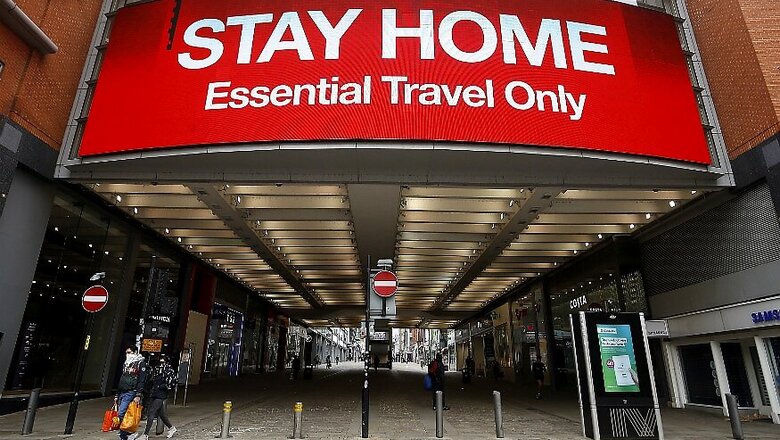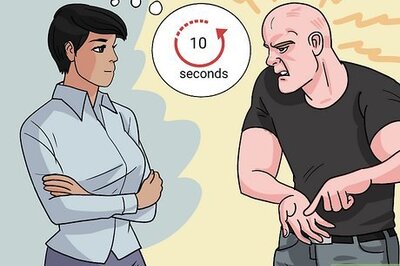
views
It has been about two weeks since the Illinois governor ordered residents to stay at home, but nothing has changed about Adarra Benjamin’s responsibilities. She gets on a bus nearly every morning in Chicago, traveling 20 miles round trip some days to cook, clean and shop for her clients, who are older or have health problems that make such tasks difficult.
Benjamin knows the dangers, but she needs her job, which pays about $13 an hour. She also cannot imagine leaving her clients to fend for themselves. “They’ve become my family,” she said.
In cities across America, many lower-income workers continue to move around, while those who make more money are staying home and limiting their exposure to the coronavirus, according to smartphone location data analyzed by The New York Times.
Although people in all income groups are moving less than they did before the crisis, wealthier people are staying home the most, especially during the workweek. Not only that, but in nearly every state, they began doing so days before the poor, giving them a head start on social distancing as the virus spread, according to aggregated data from location analysis company Cuebiq, which tracks about 15 million cellphone users nationwide daily.
The data offers real-time evidence of a divide laid bare by the coronavirus pandemic — one in which wealthier people not only have more job security and benefits but also may be better able to avoid becoming sick. The outbreak is so new that the relationship between socioeconomic status and infection rates cannot be determined, but other data, including recent statistics released by public health officials in New York City, suggests that the coronavirus is hitting low-income neighborhoods the hardest.
Concerns about getting infected have incited protests and strikes by workers in grocery stores, delivery services and other industries who say their employers are not providing them with enough protection or compensation to counter the increased health risks, even as their jobs have been deemed essential.
Rules vary among states, but essential workers generally include those in health care and public safety roles, as well as caregivers, delivery drivers, grocery clerks and plumbers. Hardware stores, pharmacies and takeout restaurants also remain open and staffed. All of these workers are able to stay on the job — a boon in an economy seized by shutdowns — but in most cases they cannot claim unemployment benefits if they quit.
“People want to talk about this virus as an equal opportunity pathogen, but it’s really not,” said Dr. Ashwin Vasan, a doctor and public health professor at Columbia University. “It’s going right to the fissures in our society.”
The mobility data provides a snapshot in time, and the behaviors it captures could change amid a fast-moving crisis. Although several public policy experts who reviewed the data said it strongly indicated that wealthier people are better able to stay home, they added that there could be other reasons for the differences — perhaps higher awareness of the risks or better access to information, for example — and others that are not yet obvious.
Economists and public health researchers said the data pointed to holes in the government’s response to the pandemic’s fallout for low-income workers, which has focused on those who have lost their jobs because of shutdowns and not on those with essential duties.
“COVID-19 is exposing a lot of the structural disadvantages that low-income people face,” including a lack of job security and uneven access to health care, said Adie Tomer, a fellow at the Brookings Institution who has studied the essential workforce. “The well-off are employed in industries where they are at a desk, and so there are some advantages built into these high-income neighborhoods during this pandemic,” he added.
In metro areas with the greatest disparity between the richest and the poorest residents — and where there are orders to stay home — people in higher-income neighborhoods have essentially halted movement. People in lower-income neighborhoods have also drastically reduced their movement, but the data shows an uptick in their movements after the third weekend of March, coinciding with the start of another workweek.
In other areas where income disparity was not as high, it was much more likely that both the richest and poorest continued to move. These cities were also in places that were less likely to have mandated that residents stay home.
Many essential workers are in lower-income jobs and have positions that require them to leave home and work face-to-face with others, economists said. “The people at this income, they’re either furloughed and not coming in to work, or they are essential construction, grocery cashiers, workers in long-term care institutions,” said Matthew Rae, who directs a program on health care markets at the Kaiser Family Foundation.
“And hundreds of thousands of them don’t have health insurance.”
Benjamin, the health worker in Chicago’s Woodlawn neighborhood, is 26 and among those without health insurance. She carries bottled soap and hand sanitizer with her and is vigilant about not touching her face. But she is worried.
“I do have gloves, but I just ran out of masks,” she said, “and I have no idea where I’m going to get any from.”
Just 15 miles north of Benjamin, in the Uptown neighborhood, John Williams has been working at home since March 16, five days before the governor’s order went into effect. A communications worker for nonprofits, Williams said people on his team were already used to telecommuting but that his husband, a high school music teacher, had faced more challenges. “Honestly, we are grateful for the privilege and security we have at the moment, knock on wood,” he said. “It’s uncomfortable, but it’s not life-threateningly scary.”
As federal lawmakers contend with shuttered businesses and millions of people suddenly out of work, little of their legislation has been tailored to help essential workers affected by the pandemic. These workers will get the same stimulus checks that other people get from the $2 trillion economic stabilization package, and the second phase of the coronavirus legislation expanded the mandate for paid sick leave related to COVID-19. But while Democrats have renewed their push to include expanded occupational safety requirements for workers, which failed to gain traction in the most recent legislation, and are also calling for additional hazard pay for workers on the front lines, it is unclear if either of those will prevail in future negotiations.
Tomer, of Brookings, said life insurance and targeted coronavirus-related health insurance for essential workers could help. “It’s about peace of mind for them and their families, and a form of compensation,” he said.
In reports from many cities, workers have alternated between fear at being exposed to the virus and relief at having a job while so many others are unemployed. Ridership on the New York subway has plummeted, but stations in poorer areas remain crowded.
In Seattle, one of the earliest coronavirus hot spots in the country, Cassandra Fejarang, a Teamsters union member, was laid off from her restaurant supply position in March but was able to find work in a Safeway grocery distribution center. She travels a few miles by car to the warehouse in Auburn, Washington.
“I’m blessed to still be able to work,” said Fejarang, 34. She said she has been pulling 10- and 16-hour shifts, loading frozen food, toilet paper, bleach and other goods onto pallets to be taken to stores. Grocery warehouse workers in her union make a good wage — $20 to $29 an hour — and have negotiated extra benefits during the coronavirus crisis.
“I definitely wear gloves and try to keep my mask on because we’re surrounded by people all day,” she said. “We are all washing our hands, trying to keep our distance. It’s hard, but I feel safe when I’m there.”
Washington state, which had the earliest known major outbreak of coronavirus in the US, stands out from the rest of the country because the wealthiest people there had nearly a week’s head start over the poorest when it came to staying home.
With this highly transmissible virus, even days can make a difference in limiting or igniting an outbreak, said Vasan, the Columbia professor.
“It’s just moving like wildfire through communities,” Vasan said. “We talk about flattening the curve, and every day people are not staying home just makes that harder.”
Vasan and other public health experts cautioned that the nature of this virus means that inequality in health outcomes puts the entire population at greater risk. Pockets of people who are untested or who don’t get the appropriate medical treatment can quickly become new clusters.
Benjamin, the home care worker, said she was proud to be essential but would feel better with assurances that she could be taken care of if she fell ill.
“I just really want people to understand that it’s hard right now to go to work and live for other people,” she said. “I want to make sure that they know we’re all in this together. Everyone is scared, but the world is in this together.”
Methodology: Cuebiq calculated distance traveled by measuring a line between opposite corners of a box drawn around the locations observed for each person on each day. The travel for each census tract is the median of these per-person distances. The Times calculated the percent change in movement by comparing the movement for the day of the week with the average for the same days of the week in January and February, with the exception of holidays. The top 10% and bottom 10% of household incomes for each metropolitan area are based on median household income data from the US Census Bureau, 2013-2017 American Community Survey 5-Year Estimates for census tracts.
Jennifer Valentino-DeVries, Denise Lu and Gabriel J.X. Dance c.2020 The New York Times Company












Comments
0 comment